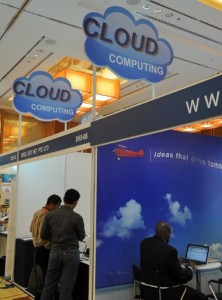Greater connectivity to define tomorrow

An exhibitor offers cloud computing, a virtual solution for data storage, at the CommunicAsia exhibition and conference in Singapore on June 23, 2011. Cloud services have been identified as one of six technologies that consumers do not know they need, but would soon be unable to live without. AFP PHOTO/ROSLAN RAHMAN
MANILA, Philippines—The “World of Tomorrow” was what everyone was treated to at the historic 1939 World’s Fair in New York, where then-ground-breaking—but now standard—technologies like fluorescent bulbs and air conditioning were unveiled.
The fair heralded the “Dawn of a New Day, and even though the event’s initial optimism was snuffed out a few years later as World War II reached America, many of the technologies launched at the fair have indeed helped usher a brighter future on earth.
Fast forward to 2012, to the recently concluded Mobile World Congress (MWC) in Barcelona, where technology companies around the globe previewed new ideas that are expected to create the next big push to propel human civilization forward.
Swedish networking company Ericsson, in its recently published “Taste of Barcelona” report that contains highlights and reflections from the 2012 MWC, said connectedness would be the main theme dominating technology headlines in the next decade.
“This affects how services are delivered both today and increasingly so in the future,” said Kursten Leins, strategic marketing for Ericsson Australia and New Zealand.
In a conference call with Manila-based journalists, Leins said the world was now on the cusp of the creation of a worldwide network of personal devices that do not only include computers, but refrigerators, television sets and even cars.
Ericsson said tech companies at MWC showed new ways for these devices to interact with each other, leading to services that consumers do not know they need, but would soon be unable to live without.
These technologies can be classified under six themes, namely: “cloud” services, ecosystems and partnerships, mobile money, heterogeneous networks, mobile devices and, most importantly, the concept of a “connected world.”
The first five categories show the growing realization among companies to form bonds with one another, and for telecommunications companies to support those partnerships by strengthening their networks, all for the common goal of providing better services to consumers.
This environment would then foster the development of ideas for the “connected world.”
Among the notable launches at the MWC was Ford’s unveiling of plans to improve the world’s “smart” transport systems that reduce the amount of human intervention in driving vehicles—thereby reducing the chances of accidents.
If road accidents do occur, Leins said the cars of the future would automatically dial for emergency services.
Scandanavian automaker Volvo also showed that its line of planned electric cars would take advantage of “smart” power grids in countries where these are available.
One of the new developments unveiled by Volvo was a charging system for electric cars that consumers power only during off-peak hours of the day as a way to cut costs.
The GSM Association, which organizes the MWC, recognized the potential of “connected cars,” declaring that by 2020, revenues from that niche of the mobile industry would be worth $600 billion.
The field of healthcare is also expected to benefit significantly from mobile technologies, Leins said.
A new project unveiled by multinational telecommunications group Orange at MWC was a new connected pacemaker for patients with heart ailments.
Having an electronic device inside a person’s body, Leins said, would be more effective than any nurse or doctor in tracking someone’s health condition.
Another standout project was an initiative to for “connected babies” by telecommunications company Etisalat.
He said in the next few years, babies, particularly those with special needs, can be given devices that can monitor their body temperatures, heart rates and other vital statistics.
“This data can be aggregated and sent to a central health service provider for analysis,” Leins said.
“These applications seem novel now, but these can also be very practical,” Leins added.
Ericsson’s own initiative called “Connected Me” does not aim to enhance the communication among devices that people own.
Instead, a new Ericsson project looks into the use of a person’s unique natural electronic current to improve his relationship with devices he owns.
“We want to be able to use your natural current to unlock the doors in your house, or have cell phones recognize their users and work only for them,” Leins said.
“It’s another novel approach, using your body as an extension to technology,” he added.
The field of e-commerce is also expected to make big strides in the next two years.
Ericsson noted that companies like Google have started looking into creating “mobile wallets” for their consumers—a field previously occupied only by telecommunications companies.
“It has been around for a while but what’s different now is that it’s getting more focus and investments from a number of players. It’s not just the telcos anymore,” Leins said.
By 2015, Ericsson forecasts that over 50 billion devices around the world—or more than five for every person on earth—would be connected to each other through the Internet.
Leins said technologies like Long-Term Evolution (LTE), also referred to as a fourth-generation (4G) mobile platform would make the “connected world” possible.
In no time, he said, the “connected world” fantasy, just like 1939’s vision of the “World of Tomorrow,” will be reality, benefiting consumers and companies alike.














